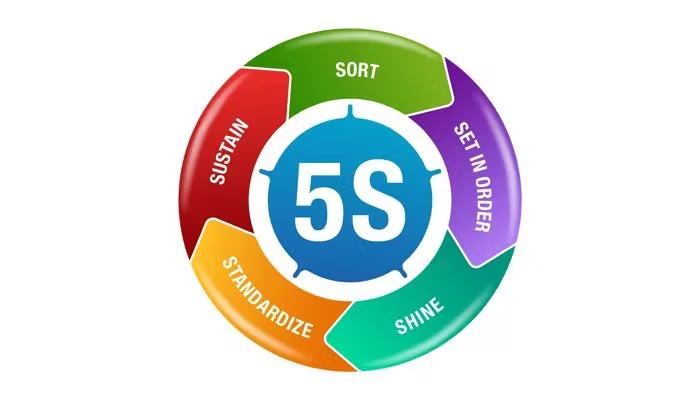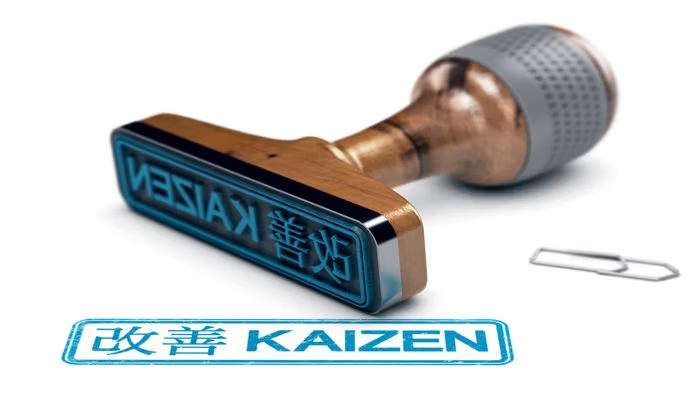Summary: Kaizen Meaning, stemming from words meaning ‘change’ and ‘good,’ goes beyond being merely an idea; it’s a lifestyle embraced by Toyota and numerous thriving organizations. Championed by Masaaki Imai, Kaizen Meaning stresses the importance of enhancements over time rather than sudden shifts. At its essence, Kaizen isn’t about refining processes; it’s about nurturing a culture of improvement across an organization.
What Does Kaizen Meaning Entail?
Kaizen Meaning is a term that signifies “change for the better” or “continuous improvement.” It represents both a philosophy and methodology centered on making constant enhancements in facets of life such as business operations, personal growth and societal interactions. Kaizen originated in Japan. Became post-World War II, especially among Japanese companies like Toyota, who adopted it as a core principle of their business practices.
Understanding Kaizen Meaning
Kaizen Meaning focuses on improvement, highlighting that even small steps forward can lead to progress in the long run. It encourages individuals and organizations to identify inefficiencies, address issues, implement solutions to drive enhancements and strive for excellence.
Ready to drive continuous improvement in your operations?
Learn how Manufacturing Operations Management software can optimize your processes and boost efficiency.
The Philosophy Behind Kaizen
Implementing Kaizen involves utilizing methods like the ‘5 Whys technique introduced by Edwards Deming to delve into problems and establish sustainable resolutions. Whether through ‘Cube Kaizen’ for short-term changes or ‘Quick Kaizen’ for enhancements, there are approaches to apply Kaizen principles for business advancement.
Core Principle: Continuous Improvement
At its core, Kaizen Meaning is rooted in the concept of betterment. It acknowledges that there is always room for growth regardless of an organization’s size or the scale of a process. Of relying on major transformations or revolutionary shifts Kaizen promotes a mindset that values gradual improvements, over time. Companies can stay ahead of the competition by looking for ways to improve efficiency, quality, and productivity. Provide more value to their clients.
Embracing the Kaizen Philosophy
Adopting a Kaizen approach involves fostering a culture of enhancement within a company. Empowering staff members at all levels to participate in the improvement process. With the Kaizen philosophy, individuals are motivated to challenge existing practices, spot areas for enhancement and take responsibility for making changes. This mindset encourages responsibility, answerability, and creativity, propelling the organization toward its objectives.
The Origin of Kaizen in Japan
Kaizen origins lie in the “Kaizen Teian” or “Kaizen Proposal.” This idea promotes individuals suggesting improvements and ideas. In firms, employees play a role in decision-making and receive recognition for their contributions to continual improvement initiatives. By engaging all staff members, organizations harness the knowledge and expertise of their workforce, resulting in results and a stronger sense of cohesion.
The Essence of the Kaizen Approach
Kaizen goes beyond tools or methodologies; it represents a culture that advocates improvement across all organizational levels. By embracing the philosophy of Kaizen, companies can enhance efficiency and productivity and foster innovation and flexibility in today’s dynamic global environment. Come with us as we delve into the nature of Kaizen and uncover how it can transform your business strategies.
The Kaizen Cycle
The Kaizen methodology follows a process known as the Kaizen Cycle or the Plan Do Check Act (PDCA) cycle. It comprises four stages: Planning, Executing, Evaluating, and Acting. This iterative method empowers organizations to systematically plan and execute improvements while continuously monitoring and adjusting their approaches.
Implementing Kaizen: Four Steps Towards Success
The implementation of Kaizen follows a structured approach, often aligned with Lean management methods to drive continuous improvement. Here are the four essential steps to adhere to:
1. Identify Improvement Areas:
Start by pinpointing areas within your organization or processes that stand to benefit from enhancements. This might involve analyzing data, conducting staff surveys or observing workflows. The aim is to identify areas for improvement.
2. Plan and Execute Changes
Create a change plan once improvement areas are identified. This plan should detail actions to be taken, required resources and implementation timelines. Engaging the stakeholders and effectively communicating the strategy is crucial to ensure their support and collaboration.
3. Review
Once the changes are implemented, assessing their impact and reviewing the outcomes is vital. This includes gathering data, analyzing performance indicators and comparing them to the benchmarks. By evaluating the results, you can gauge the effectiveness of the changes and pinpoint any required adjustments or enhancements.
4. Establish and Maintain
To guarantee success, it’s essential to establish standardized processes and uphold the implemented changes. This involves documenting the updated procedures, training staff on the revised approaches and instituting a system for monitoring and feedback. These documented, repeatable procedures form the basis of standard work, helping teams sustain improvements over time. By integrating these changes into your ethos, you can foster a culture of improvement that becomes intrinsic to your operational practices.
The PDCA Methodology
The PDCA (Plan Do Check Act) methodology is an element of the Kaizen philosophy. It offers an approach to problem-solving and continual enhancement. The PDCA cycle encompasses these stages;
Planning
During this phase, you pinpoint issues or areas for improvement, establish objectives, and devise a comprehensive action plan. This entails analyzing data, gaining insights and determining the course of action.
Implementation phase
Put the plan into action. Carry out the proposed changes. This could involve testing methods, running small-scale pilot projects or making improvements regularly.
Checking phase
Assess the outcomes. Measure them against the intended objectives. This stage includes gathering data, monitoring performance metrics and evaluating the implemented changes’ effectiveness.
Acting
Take steps based on the assessment and feedback from stages. This may involve standardizing processes, modifying or expanding the changes more broadly. The PDCA cycle is a loop that signifies a process of enhancement. It enables organizations to iterate and perfect their strategies over time, fostering advancement and helping them stay competitive in an evolving business landscape.
Just In Time (JIT) within Kaizen
Linked with Kaizen Meaning, just in Time (JIT) is a concept commonly used in lean manufacturing. JIT focuses on eliminating waste by delivering products or services in quantity at the time to minimize inventory levels and shorten lead times. In the realm of Kaizen, Just In Time (JIT) underscores the significance of streamlining operations, cutting out steps and axing any tasks that don’t contribute value to the final product or service. By embracing JIT principles, companies can boost effectiveness, slash expenses and elevate customer satisfaction.
Putting Kaizen into Action
The system is a systematic approach to organizing and standardizing workplaces. It serves as the cornerstone of Kaizen by offering a framework for enhancing efficiency, safety and productivity.
5S principles
The 5 S principles encompass:
1. Sort: Go through items in the workspace. Categorize them as essential or nonessential. Eliminate items to establish a well-organized setting.
2. Set in Order: Arrange the items left efficiently. Allocate spots for tools, equipment and supplies to ensure access while minimizing time wasted searching for items.
3. Shine: Upkeep the workspace. Set up cleaning routines and protocols to maintain a safe environment. This helps prevent equipment breakdowns, lowers accident risks and fosters workplace pride.
4. Standardize: Set standards and procedures for upholding a workspace. Communicate Document processes to all staff members. To maintain consistency and ensure operations, it’s important to establish a culture of continuous improvement. This involves encouraging employee discipline and accountability, promoting adherence to the principles and providing training and support. Regularly reviewing and reinforcing these practices is essential for sustaining long-term improvements.

Gemba: The Importance of Going to the Source
Implementing the methodology allows organizations to optimize their work environments, minimize waste, boost productivity and lay the groundwork for Kaizen initiatives. In the context of Kaizen, “Gemba” highlights the significance of visiting where work takes place – be it a factory floor, customer service center or construction site. This approach underscores the value of observations in understanding processes and identifying areas for enhancement. When practicing Gemba visits, managers should embrace an attitude characterized by curiosity rather than judgment. To promote communication, leaders must ask open-ended questions, actively listen to their team members’ viewpoints and encourage them to share their thoughts and suggestions for enhancing the work environment. This collaborative approach fosters a sense of ownership among employees. Empower them to actively participate in improvement initiatives.
Value Stream Mapping and Kaizen
Value Stream Mapping (VSM) is a tool utilized in Kaizen methodology to analyze and enhance the flow of materials, information and activities for delivering a product or service. It offers a perspective on the entire value stream, starting from when a customer initiates an order until the final product or service is delivered. Creating a value stream map involves outlining the state of operations within the value stream, pinpointing areas of inefficiency and waste and devising a state that enhances efficiency by eliminating non-value-added tasks. Value Stream Mapping enables organizations to identify areas for enhancement by representing the process and identifying sources of waste, like overproduction, excess inventory, unnecessary transportation, waiting periods and defects. Organizations can streamline processes, reduce lead times, boost quality standards and elevate customer satisfaction by analyzing the value stream and applying Kaizen principles.
Kaizen Workshops; Quick Improvement Sessions
Kaizen workshops, also called Kaizen blitzes or rapid improvement sessions, are activities designed to make significant enhancements quickly. These workshops involve teams from departments working together to analyze and enhance a process or issue. Typically lasting from days to a week, Kaizen workshops require team members’ full commitment to the improvement project. These sessions promote urgency, encourage teamwork and enable decision-making. They are especially beneficial for tackling long-standing issues that need attention and fresh insights. Kaizen workshops can be highly effective in improving employee engagement and building momentum for improvement initiatives. However, it’s essential to view them as part of an improvement process rather than standalone events. Maintaining the improvements made during the workshop necessitates follow-up actions, standardization processes and continual monitoring.
The Advantages of Continuous Improvement
One advantage of improvement is the boost in productivity and effectiveness it brings. Companies can achieve productivity levels while maintaining high standards by looking for ways to cut down on waste, streamline operations and optimize processes. Gradual enhancements in productivity over time can lead to improvements and a competitive edge.
Waste Reduction
Continuous improvement concentrates on recognizing and eliminating forms of waste, including production, surplus inventory, defects, delays, unnecessary transportation and activities that do not add value. By eliminating waste, organizations can use their resources, lower costs, shorten cycle times and enhance operational efficiency.
Empowering Staff Members and Cultivating a Culture of Ongoing Enhancement
Improvement stresses the importance of engaging all employees in the enhancement process. It encourages individuals to share their ideas, recommendations and expertise to bring about changes. By fostering a culture focused on development, organizations create an atmosphere where employees feel valued and involved. Inspired to find better methods. When employees actively participate in improvement efforts like this one from Kaizen initiatives, they develop a sense of responsibility for their work. They show dedication towards achieving company objectives and are more open to adapting to new work methods.
FAQ | Kaizen Meaning
What is Kaizen Lean and why does it matter?
Kaizen Lean combines the principles of continuous improvement (Kaizen) with Lean management methods to eliminate waste and enhance efficiency. This approach encourages small, ongoing changes that drive long-term process optimization, employee involvement, and higher quality in operations.
How does Kaizen impact daily operations and long-term success?
Kaizen improves daily operations by fostering a culture of continuous improvement, where employees regularly identify inefficiencies and implement small but impactful changes. This leads to smoother workflows, reduced waste, and higher quality output.
In the long term, organizations that embrace Kaizen experience greater adaptability, sustained cost savings, and a stronger competitive edge by continuously optimizing their processes and engaging their workforce in problem-solving.
How does Kaizen differ from other improvement methodologies?
As a key aspect of lean management methods, it emphasizes small, incremental changes over time, involving all employees in the improvement process. It focuses on eliminating waste, streamlining processes, and fostering a culture of continuous improvement. Other methodologies, such as Six Sigma or Lean, may involve more significant changes or specialized tools and techniques.
Who can participate in Kaizen initiatives?
It encourages the involvement of all employees, regardless of their position or department. It recognizes that those directly involved in the work have valuable insights and knowledge. By engaging everyone in the improvement process, organizations can tap into a wider range of ideas and perspectives.
How long does a typical Kaizen event take?
The duration of a Kaizen event can vary depending on the complexity of the problem or process being addressed. It can range from a few days to a week. The concentrated effort during the event allows for rapid problem-solving and implementation of improvements.
What is Gemba, and why is it important in Kaizen?
Gemba refers to the actual place where work is done, such as the shop floor, office or service area. It is essential in Kaizen because it allows managers and employees to observe the work processes firsthand, understand the challenges and identify opportunities for improvement. Gemba walks provide valuable insights and promote a deeper understanding of the work environment.
How does Value Stream Mapping (VSM) support Kaizen?
Value Stream Mapping is a visual tool used to analyze and improve the flow of materials, information and activities required to deliver a product or service. It provides a holistic view of the entire value stream, identifies areas of waste and inefficiency and helps design a future state that optimizes the flow and eliminates non-value-added activities.
What are real-world examples of Kaizen in action?
- Automotive: Toyota refines its assembly lines by continuously reducing waste and improving production efficiency through small process adjustments.
- Healthcare: Hospitals use Kaizen to cut patient waiting times and streamline workflows, improving overall care quality.
- Retail: Stores optimize inventory management and checkout processes to reduce errors and enhance customer experience.
- Manufacturing: Factories minimize material waste and improve equipment maintenance to increase efficiency and reduce downtime.
- Office environments: Teams simplify administrative processes and standardize best practices to boost productivity and eliminate unnecessary tasks.
Image: Adobe Stock – Copyright: © Olivier le Moal – stock.adobe.com





